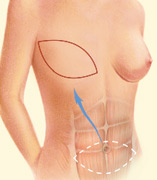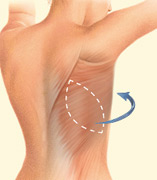The Procedure
Types of Breast Reconstruction
Your breast reconstruction surgery can be achieved through a variety of different techniques. The appropriate reconstructive procedure for you will be determined based on discussions with your surgeon, your body type, and prior therapy and/or surgical treatment.
Implant Reconstructions
• Expander/Implant
First, a temporary device known as a tissue expander is placed in the breast to create the soft pocket that will contain the permanent implant. Some surgeons may also use an acellular dermal matrix to assist with reconstruction. Once expansion is complete, the expander will be exchanged for the permanent implant during an outpatient procedure. In expander/implant reconstructions, patients can expect the following to occur with some exceptions:
Hospital Stay (Mastectomy/Expander): 1 - 2 days
Recovery Time (Mastectomy/Expander): 4 - 6 weeks
Hospital Stay (Implant Exchange): Outpatient
Recovery Time (Implant Exchange): 1 - 2 weeks
• Direct-to-Implant
This approach allows for a breast implant to be placed immediately following mastectomy, foregoing the need for a tissue expander. Some patients may still require a secondary procedure. In direct-toimplant reconstructions, patients can expect the following to occur with some exceptions:
Hospital Stay: 1 - 2 days
Recovery Time: 4 - 6 weeks

Flap Reconstructions
• Donor Site: Abdomen
TRAM flap: The most common method of tissue reconstruction is the pedicled transverse rectus abdominus myocutaneous (TRAM) flap. In this approach, abdominal muscle, tissue, skin, and fat are used to create breast shape. The patient will have the benefit of a flatter looking abdomen. The scar on the abdomen is low and extends from hip to hip. In TRAM flap reconstructions, patients can expect the following to occur with some exceptions:
Hospital Stay: 2 - 5 days
Recovery Time: Several weeks to several months
• Donor Site: Abdomen


Abdominal free flap: These microsurgical (DIEP, SIEP) procedures may or may not use the actual abdominal muscle, so they may allow for results with fewer donor site complications. However, they are lengthier procedures and have the potential for other complications. These procedures should only be performed by plastic surgeons who perform microsurgery regularly and in institutions with experience in monitoring these flaps. In free flap reconstructions, patients can expect the following to occur with some exceptions:
Hospital Stay: 3 - 5 days
Recovery Time: Several weeks to several months
• Donor Site: Back
LD flap: The latissimus dorsi (LD) flap is most commonly combined with an implant. At the time of breast reconstruction, the muscle flap, with or without attached skin, is removed from the back and implanted in the breast. This flap provides a source of soft tissue that can help create a more natural looking breast shape compared to an implant alone. The scar on the back can often be concealed under a bra strap. In LD flap reconstructions, patients can expect the following to occur with some exceptions:
Hospital Stay: 1 - 3 days
Recovery Time: Several weeks




• Donor Site: Buttock
GAP flap: The gluteal artery perforator (GAP) free flap uses skin and fat from the buttocks. This type of reconstruction is technically more difficult to perform than other procedures. Also, the tissue from the buttock is somewhat harder to shape into a breast. In GAP free flap reconstructions, patients can expect the following to occur with some exceptions:
Hospital Stay: 3 - 5 days
Recovery Time: Several weeks
• Donor Site: Thigh
Inner thigh free flap: This procedure uses skin, fat, and muscle from the inner portion of the upper thigh to reconstruct the breast. The tissue is dissected from the inner thigh and transplanted to the chest where it is reattached using microsurgery. The resulting thigh scar is generally well hidden. In thigh free flap reconstructions, patients can expect the following to occur with some exceptions:
Hospital Stay: 3 - 5 days
Recovery Time: Several weeks
